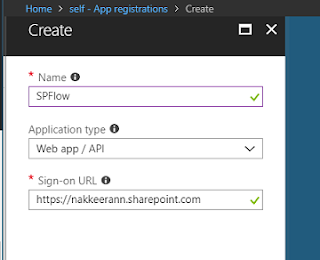Here, let us look how the custom connectors can be created
for accessing SharePoint data on Microsoft Flow.
Microsoft Flow provides multiple connectors from various
services including SharePoint to work with the data. The connectors contain
multiple triggers and actions. For SharePoint connector by Out of the Box, Microsoft
provides 8 triggers and 28 actions on Microsoft flow.
UseCase: Imagine you want to retrieve the SharePoint user profile
data of some user. Currently there is no action available for MS Flow
developers to retrieve SharePoint user profile data. Such triggers and actions
can be created by developers on the Microsoft Flow platform. In this post, let
us look how one such custom action can be created and used on the Microsoft
Flow platform.
The configuration involves the following steps.
- Configuring Azure AD Application, which provides necessary permissions and helps in authenticating the calls made from Microsoft Flow.
- Generating the collection file (Swagger) using postman tool, which will be used as base file while building the custom connector.
- Configuring the custom connector, which will make call to SharePoint to get the required data with necessary inputs.
- Testing the custom connector created above.
- Creating/Configuring the flow, which will also use the custom connector we have created above.
Configure Azure AD Application for Flow Authentications:
- Create a new app on the Azure Active directory.
